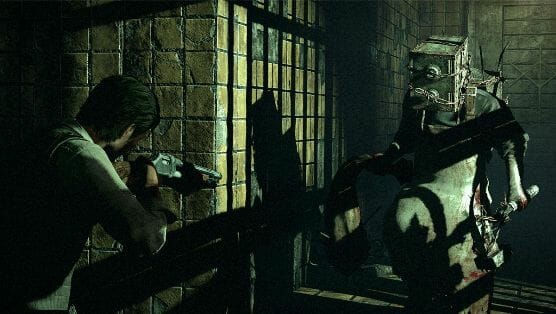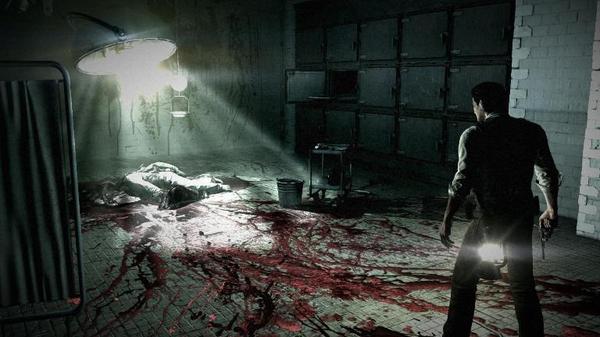
The grizzled police detective recoils as he opens Beacon Mental Hospital’s front door. His young partner walks up next to him, saying “It smells like blood” inside. The main entrance hall to the building is strewn with corpses and, as predicted, splashed with ample amounts of gore. Rather than induce any real fear, this macabre scene works mainly to set the stage for what’s to follow: to give The Evil Within’s players exactly the kind of grim welcome they expect from a revival of the survival horror game. As the prologue continues and detective/protagonist Sebastian Castellanos finds himself escaping a cannibalistic butcher, wading through the attending viscera of his filthy kitchen and, finally, dropping feet-first into a human-sized vat of murky red liquid, it becomes pretty clear that this is a game that—like the bygone genre it continues the tradition of—positively stinks of blood.
It’s a big deal when Shinji Mikami, co-founder of Tango Gameworks and director of its debut, The Evil Within, decides to make a high-profile return to the brand of horror he created with 1996’s Resident Evil. Scary games have changed a lot since then, moving away from the kind of slow-paced puzzle-laden survival titles Mikami helped popularize nearly two decades ago to embrace the more immediate satisfactions of shooting monsters with big guns. The Evil Within is meant, in large part, to turn back the clock on the genre and lavishly answer the question of what a mainstream horror game from the turn of the century would look like if designed today.
It isn’t entirely surprising that the end result often feels as distinct as it does dated.
After proving its survival horror aesthetic with the theatrical grotesqueries of its opening, The Evil Within defines its gameplay goals by presenting the player with a gun and murderous enemies to fight off. Sebastian, having fled the surreal nightmare of the introduction’s asylum only to find himself inexplicably trapped within a series of strange waking dreams, wanders through a misty, moonlit forest, surrounded on all sides by zombie-like monsters. The pistol he grabs upon discovering the first of these creatures isn’t a lot of help, though. It only comes with six bullets and, after using most of them to take down a single enemy, there are only one or two left to pick up in the environment. From this point on, the game demands that the player get crafty, dispatching monsters by sneaking up from behind and providing a vicious stab to the skull, slipping past them by crouching through the shadows or repurposing parts from the traps strewn around the environment to turn into crossbow bolts. Though there are new weapons to find and combat skills to upgrade during the rest of the game’s chapters, quick-thinking and making do with limited firepower remain constant necessities throughout the entire experience. The survival elements of The Evil Within involve careful resource management and a judicious exercise of both fight and flight responses when danger nears.
The variety of tools at the player’s disposal—stealth kills, evasion and the occasional application of weaponized violence—initially seem to offer a promising level of gameplay freedom. But Sebastian is extremely fragile: he dies after one or two close run-ins with an enemy or a single blunder into a tripwire mine. The squashed, claustrophobic perspective afforded by the game’s letterboxed presentation (two heavy black borders dominate the top and bottom of the screen) mix with disorienting level design, thick with unseen dangers lurking around corners and hiding underfoot, to make death frustratingly frequent. There’s nothing wrong with a difficult game, but all too often the combination of poor visibility and powerful enemies (sometimes capable of inflicting one-hit kills) evaporates tension and replaces it with the tedium of long loading times, unforgiving checkpoint placement and trial-and-error approaches to progressing through difficult sections. In its best moments, The Evil Within provides the player with a decent amount of ammunition, a spare syringe full of health-restoring medicine and, most importantly, an understanding of the environment’s layout. At times like these—times when the difficulty is diminished enough to compensate for overly punishing camera perspectives and combat design—it’s a lot easier to appreciate the interplay between the game’s many systems and free-form approach to dealing with enemies.
Mostly, though, The Evil Within finds success in the atmosphere it creates. There’s a sly, winking tone to the entire game, represented most strongly by the strains of Debussy’s Claire de Lune that play whenever Sebastian nears one of the broken mirrors capable of transporting him back to his hospital home base. The game revels in setting this warmly beautiful melody in opposition to miserable environments covered with industrial grime, blood and corpses. As self-serious as the plot’s ham-fisted exploration of murderous psychopaths and emotionally tortured detectives can be, the game maintains a level of distance from its well-worn horror premise that is ultimately pretty charming. This effect is furthered by the many references to survival horror classics littered throughout the game. In one early example, Sebastian is introduced to the game’s zombie-like creatures by way of a nearly frame-by-frame recreation of the first Resident Evil’s iconic monster reveal. The detective calls out to a crouched figure, back turned away from the camera. The man glances over his shoulder, showing a grotesque face bloodied from the corpse he’s been munching on, and stumbles out to attack Sebastian. It’s a bit of the past creeping into the present. In other instances, a showdown with a box-headed giant in a dirty butcher’s apron acts as a clear callback to Silent Hill 2’s Pyramid Head; a fight against two enormous, shirtless men is a reminder of Resident Evil 4’s troll-like El Gigante; a boss fight against a mutated, canine monster evokes Resident Evil’s window-shattering demon dogs.
None of this would amount to much more than a lazy appeal to nostalgia if Tango Gameworks didn’t seem so earnest in its homage and proud to carry on the tradition of the survival horror games of which Shinji Mikami serves as a de facto godfather. The developers’ attempt at updating the genre for modern audiences often feels as if it’s struggling under the weight of that ambition. What it does accomplish, though, is often enough to redeem the whole enterprise. The Evil Within may be rough around the edges in presentation and execution, yet it is rich in not just recreations of great horror moments from years past, but also in the introduction of new, memorable ones of its own. Traditional survival horror games aren’t likely to spring back into relevance on the back of what The Evil Within accomplishes. But its ultimate impression—that of a savvy Greatest Hits-styled overview of the genre—may inspire new ways of thinking about what it is exactly we loved about horror games in the past.
The Evil Within was developed by Tango Gameworks and published by Bethesda Softworks. Our review is based on the PlayStation 4 version. It is also available for PC, Xbox One, Xbox 360 and PlayStation 3.
Reid McCarter is a writer and editor living and working in Toronto whose work has appeared at Kill Screen, Pixels or Death and The Escapist. He also maintains the videogame site Digital Love Child and tweets things @reidmccarter.
